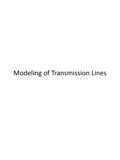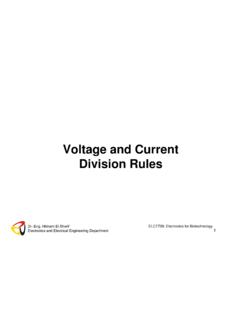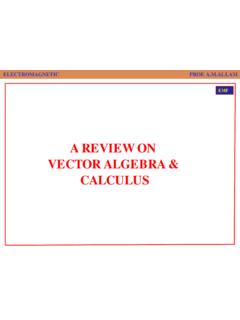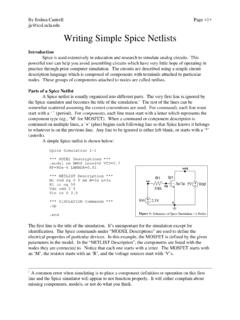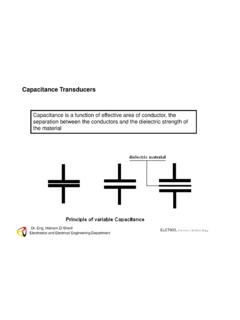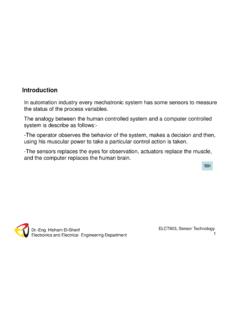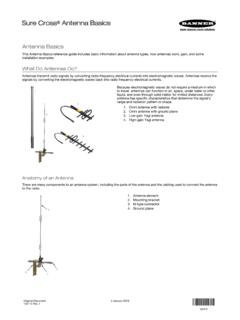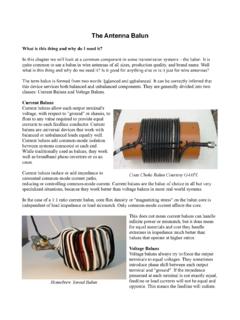Transcription of WHY ADAPTIVE (SMART) ANTENNAS? - GUC - …
1 ADAPTIVE ANTENNAS. PROF. 1 WHY ADAPTIVE ( smart ) ANTENNAS? ADAPTIVE ANTENNAS ADAPTIVE ANTENNAS. PROF. 2 1-Why are smart antenna (SA) and ADAPTIVE antennas (AA) emerging now? The concept of smart antennas has been around since the late 50s [1 3] AA systems capabilities where limited because ADAPTIVE algorithms were usually implemented in analog hardware ADCs, which have high resolutions and sampling rates up to 100 GSa/s [4] makes the direct digitization of most radio frequency (RF) signals possible in many wireless applications In addition, DSP can be implemented with high speed parallel processing using field programmable gate arrays (FPGA) The global demand for all forms of wireless communication and sensing continues to grow at a rapid rate, SA( or AA ;where an ADAPTIVE algorithms are involved) are the practical realization of the array signal processing and have a wide range of interesting applications: The rapid growth in telecommunications alone is sufficient to justify the incorporation of SA or an AA to enable higher system capacities and data rates Mobile wireless communications [5] -Software-defined radio [6, 7]-WLAN [8]- Wireless local loops (WLL) [9]-Mobile Internet-Wireless metropolitan area networks (WMAN) [10]-Satellitebased personal communications services-radar [11,12]- Remote sensing-Mobile ad hoc networks (MANET) [13]-High data rate communications [14]- Satellite communications [15]-Multiple-in-multiple-out (MIMO) systems [16]-Waveform diversity systems [17] The technology required to make the necessary rapid and computationally intense calculations has only emerged recently ADAPTIVE ANTENNAS.
2 PROF. 3 Transmission over TL are cost effective, more attenuation, more power loss Transmission over OF are excellent but expensive Approach ADAPTIVE ANTENNAS. PROF. 4 Transmission over TL are cost effective, more attenuation, more power loss Transmission over OF are excellent but expensive COMPRESS DATA FOR EFFICIENT TRANSMISSION ADDING SOME BITS FOR DETECTION AND COORECTION Reducing multipath propagation effects Increasing channel capacity (interference cancellation) Enhancing S/N Minimizing power consumption Efficient spectrum use Immunity to noise or jamming But it needs Wireless transmission is the best cost effectiveness ADAPTIVE ANTENNAS. PROF. 5 On the other hand there are two main problems in any communication systems: 1-How to acquire more capacity to increase the number of user at lower cost maintaining the QoS 2-How to obtain greater coverage to decrease the infrastructure and maintenance cost , the two requirements for the service provider are CAPACITY & COVERAGE which are inversely related Let us see the multiple access techniques which can achieve large number of users for the same cost ADAPTIVE ANTENNAS.
3 PROF. 6 A unique frequency slot is assigned to each user for the duration of their call The number of users within a cell is determined by the number of distinct frequency slots available Frequency FDMA At the same frequency a user can access the channel at any specific time Each user is assigned a distinct time slot to access the channel Time TDMA It is a spread spectrum technique, which uses spreading codes to allow the users to transmit simultaneously at the same frequency Each users signal occupies the entire bandwidth CDMA ADAPTIVE ANTENNAS. PROF. 7 Space domain processing remains as the most promising, if not the last frontier in the evolution of multiple access systems Andrew Viterbi Space diversity is the main idea of ADAPTIVE or smart antennas SDMA It allows different users to use the same spatial system resources Performance System complexity ADAPTIVE ANTENNAS.
4 PROF. 8 2-Evolution from omni-directional to smart antennas (SA) (TECHNOLOGY DEVELOPMENT LEVEL) [18] To achieve the capacity required for thousands of subscribers for limited number of channels or frequencies, a suitable cellular structure is to be designed Cell Sector Base station At the center of each cell, a base station equipped with an omni-directional antenna with certain bandwidth Cellular structure Cellular networks divide a overage area into multiple cells, each has its own radio infrastructure and users ADAPTIVE ANTENNAS. PROF. 9 Frequency reused is applied for different cell clusters to increase the number of subscribers Cluster Omni-directional antenna transmits equal intensity in azimuth plane and directive in elevation, hence, only small percentage of the total energy reaches the desired direction As the number of users increases, more interference occurs for those in the same or adjoining cells and hence reducing the capacity Cell splitting is the immediate solution for this problem.
5 It subdivides a crowded cell into smaller cells called micro cells, each with its own base station and a corresponding reduction in antenna height and transmitting power are achieved Disadvantages for cell splitting; it's costly due to installing new base stations, increasing the number of handoffs and a higher processing load per subscriber ADAPTIVE ANTENNAS. PROF. 10 Sectorization is the solution : antenna system ( phased array) are replacing the omni directional antenna . It provides more frequencies for more subscriber per coverage area. This is called the sectoring technique Typically, a cell is sectorized into three sectors of 120 each It improves signal-to-interference (S/I ) ratio and capacity Co-Ch I is the interference between adjacent clusters ADAPTIVE ANTENNAS. PROF.
6 11 The penalty due to channel sectoring at the base station is an increase in the number of antennas at base stations Diversity offers an improvement in the effective strength of the received signal by mitigating the multipath effects using: -Switched diversity: at a given moment, the system continually switches between antennas (connects each of the receiving channels to the best serving antenna ) - Combining diversity : This approach corrects the phase error in two multipath signals and effectively combines the power of both signals to produce gain. Other diversity systems, such as maximal ratio combining systems, combine the outputs of all the antennas to maximize the ratio of combined received signal energy to noise ADAPTIVE ANTENNAS. PROF. 12 Although this approach mitigates severe multipath fading, in high-interference environments, the simple strategy of locking onto the strongest signal or extracting maximum signal power from the antennas is clearly inappropriate and can result in clear reception of an interferer rather than the desired signal The need to transmit to numerous users more efficiently without compounding the interference problem led to the next step of the evolution antenna systems that intelligently integrate the simultaneous operation of diversity antenna elements ( smart ANTENNAS OR ADAPTIVE ANTENNAS ) A base-station with circular ADAPTIVE antenna arrays Array of simple10 dBi dipole antenna elements operating at 2 GHz of size ~ * m ADAPTIVE ANTENNAS.
7 PROF. 13 Hence, SA can integrate radio intelligence of the DSP with antenna array technology to: Enhance communication system performance including Improve link quality for transmission and reception Interference cancellation on the up and down links SNR improvement due to antenna gain Mitigation of fading Capacity Coverage range Quality of service, (QoS), Bit rate, Mobility rate Directionally send down link information Save energy Provides N-fold diversity gain ADAPTIVE ANTENNAS. PROF. 14 ) SOIdirect the beam maxima to the signal of interest ( beam steering:-1 ) SNOI direct the beam minima to the signal not of interest ( beam nulling:-2 allowing different users to use the same spatial system Spatial diversity:-3resources (SDMA) This can be accomplished by: There are many terms commonly used to describe SA (array antenna with processor to perform the beam steering ) like AA (if the ADAPTIVE algorithms involved) , intelligent antennas , digital beam forming, phased array with signal processor, spatial processing, SDMA.
8 ADAPTIVE ANTENNAS. PROF. 15 3-Analogy of auditory and electronic adaptation [18 ] ADAPTIVE ANTENNAS. PROF. 16 ADAPTIVE ANTENNAS. PROF. 17 4-Definition of smart or ADAPTIVE Antennas (SA or AA) A system consisting of an antenna array and an ADAPTIVE processor that can perform filtering in both the space and frequency domain An antenna that controls its own pattern, by means of feedback control, while the antenna operates. Some ADAPTIVE antennas also control their own frequency response An ADAPTIVE or a smart antenna is an antenna array with a digital or ADAPTIVE signal processor in order to control its pattern direction and power intensity Any antenna array, terminated in a sophisticated signal processor, which can adjust or adapt its own beam pattern in order to emphasize signals of interest and to minimize interfering signals ADAPTIVE ANTENNAS.
9 PROF. 18 Typical block diagram of SA It is a traditional antenna array It is a fixed beam array where the main lobe can be steered by defining the fixed array weights w Is it an ADAPTIVE array? X weights beam pattern No No No No No Is neither smart nor ADAPTIVE ADAPTIVE ANTENNAS. PROF. 19 If the algorithms used are ADAPTIVE it is called ADAPTIVE array The complex weight computation based on different criteria is incorporated in the signal processor in the form of software algorithms It is an smart array It needs a reference signal or DOA X weights Output y Desired y Same? No, error X modified weights Optimum y Compute modified w Modified Output y Same? yes ADAPTIVE ANTENNAS. PROF.
10 20 20 ADAPTIVE Signal Processor: The weights are continuously adjusted by the ADAPTIVE signal processor (AA) in order to achieve the input function antenna Array: antenna elements are assumed to be identical with an nondirectional pattern in the azimuthally plane Complex Weights: they adjust the amplitude and phase of the signal which are computed by the DSP unit Components of SA (AA) System It should be pointed out that the signal processing is carried out in base band ,: -The signal is passed from each antenna element to the RF front end where LNPA, mixers and analogue filters are used for down conversion to IF -The signal is converted to digital base band using ADC -Combined using smart algorithm in a digital signal processor antenna system RF Front end ADC; Digital frequency conversion Digital signal processing RF IF BASE BAND ADAPTIVE ANTENNAS.
